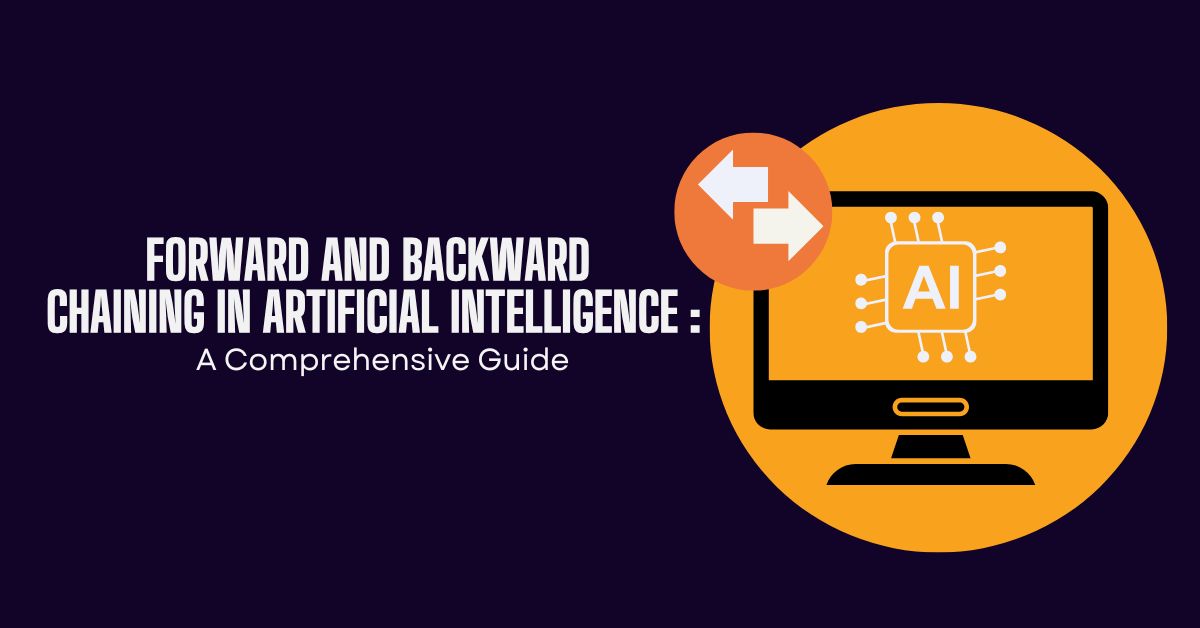# Forward and Backward Chaining in Artificial Intelligence: A Comprehensive Guide
Artificial intelligence (AI) has revolutionized the way we think about and interact with technology. At the heart of AI are methods for making logical inferences, which allow systems to solve problems and make decisions. Two of the most fundamental inference methods in AI are forward chaining and backward chaining. Understanding these methods can provide valuable insights into how AI systems derive conclusions from data and rules. In this comprehensive guide, we will delve into the intricacies of forward and backward chaining in artificial intelligence, exploring their definitions, applications, and the differences between the two. By the end of this guide, readers will have a clear understanding of these methods and their relevance in AI.
## What is Forward Chaining?
Forward chaining is a data-driven inference method used in artificial intelligence. It starts with the available data and uses inference rules to extract more data until a goal is reached. The process involves firing rules sequentially to infer new facts from existing ones, gradually moving from the known to the unknown. This approach is often utilized in situations where all possible outcomes need to be explored from a given set of facts.

To illustrate forward chaining, consider a simple example in a medical diagnosis system. The system might have various rules, such as “If the patient has a fever and a cough, then the patient might have the flu.” Starting with known data, like symptoms reported by a patient, forward chaining fires applicable inference rules continuously to deduce a diagnosis.
Example: Suppose a patient reports having a fever and a cough. In a forward chaining system, the corresponding rule might fire, deducing that the patient could potentially have the flu.
## What is Backward Chaining?
Backward chaining is a goal-driven inference method in artificial intelligence. It starts with a goal and works backward to determine what data or conditions must be true for that goal to be achieved. This method is particularly useful in scenarios where specific conclusions need to be reached, and it is efficient in narrowing down the path to those conclusions by working from the outcome back to the data.

For example, consider a legal expert system tasked with determining the validity of a contract. If the goal is to conclude whether the contract is legally binding, backward chaining would start with this conclusion and systematically identify the conditions required for the contract’s validity, verifying each condition against available data.
Example: In a legal setting, backward chaining would involve starting with the goal of proving a contract is valid, and checking backward through the necessary legal criteria to see if all are met using the available facts.
## Differences Between Forward and Backward Chaining
Though both forward and backward chaining are methods used in AI for making inferences, they differ significantly in their approach and application. Below is a comparison of these two methods:
| Aspect | Forward Chaining | Backward Chaining |
|---|---|---|
| Inference Type | Data-driven | Goal-driven |
| Starting Point | Begins with known information | Begins with an end goal |
| Use Cases | Exploratory problem-solving, diagnostic systems | Proof-oriented systems, expert systems |
| Complexity | Potentially high if many rules are triggered | More directed, potentially lower complexity |
| Efficiency | Best for comprehensive rule exploration | More efficient for specific goal achievement |
## Applications in Artificial Intelligence
Understanding the applications of forward and backward chaining in AI helps elucidate their individual and collective significance in real-world scenarios. Both these chaining methods are employed in various AI domains, leveraging their specific strengths to achieve different goals.
- Expert Systems: Both forward and backward chaining are used in expert systems that emulate the decision-making capabilities of a human expert in domains like medical diagnosis, finance, and law.
- Rule-Based Systems: These chaining methods are integral in rule-based systems, especially those that deal with large rule sets, by ensuring efficient rule selection and firing processes.
- Natural Language Processing (NLP): Chaining methods assist in language understanding and processing, enhancing AI’s ability to interpret and generate human language by deriving context and meaning.
- Decision Support Systems: AI systems supporting decision-making employ forward and backward chaining to analyze data and provide comprehensive recommendations.
- Problem Solving in AI: Chaining processes are crucial for AI systems aimed at solving complex problems, allowing them to deduce solutions systematically from known data or desired outcomes.
## Advantages and Disadvantages
Each chaining method comes with its own set of advantages and disadvantages, making them suitable for different types of AI tasks. Here, we explore the pros and cons of forward and backward chaining:
- Forward Chaining Advantages:
- Well-suited for situations with numerous known facts and when multiple outcomes are possible.
- Simple to implement in scenarios requiring comprehensive data exploration.
- Forward Chaining Disadvantages:
- Can become computationally expensive due to the broad search of rule space.
- Risk of unnecessary rule firing, leading to inefficiency if not properly managed.
- Backward Chaining Advantages:
- Efficient for systems needing specific goal verification, reducing computation time by focusing on goal achievement.
- Directed approach minimizes exploration of irrelevant data paths.
- Backward Chaining Disadvantages:
- Not ideal for situations with vague or many potential goals.
- Dependency on predefined rules and goals might limit flexibility.
## Case Studies
Case studies provide concrete examples of how forward and backward chaining have been applied successfully in various AI systems. Here, we present two such case studies:
Case Study 1: Medical Diagnosis System
A medical expert system utilizing forward chaining was developed to diagnose diseases based on symptoms and test results. By systematically applying the rules from a vast database, the system could derive potential diagnoses, verify them, and recommend treatments. This comprehensive exploration of possibilities made the system valuable in assisting medical professionals with complex diagnostic processes.
Case Study 2: Legal Expert System
In a legal environment, a backward chaining system was implemented to verify contract validity. Starting from the desired conclusion of contract validity, the system worked backward through legal criteria and available evidence. This directed inference process efficiently reduced the need for exhaustive examination of irrelevant information, making it a powerful tool for lawyers and legal analysts.
## Conclusion
Forward and backward chaining in artificial intelligence are instrumental concepts that help AI systems infer new information and achieve goals. Both methods offer unique strengths and are applied across various domains to optimize problem-solving and decision-making processes. By understanding the nuances of forward and backward chaining, AI practitioners can better assess which method is more suitable for specific tasks or contexts. As AI continues to evolve, refining these inference methods will be crucial in enhancing system efficiency and reliability. We encourage continued exploration into AI inference methodologies to harness their full potential.
## References and Further Reading







